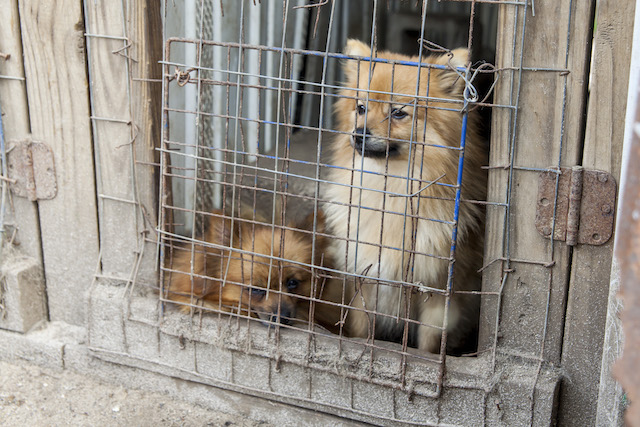A few days ago I came across an article on Phoenix New Times’ website. The article titled Top 10 Reasons Banning “Puppy Mill” Dogs From Pet Stores Is Pointless, lit a fire deep within myself. The article, although not advocating for puppy mills, listed the top ten reasons people think banning puppy mill dogs are a bad idea.
I spent a month investigating, researching and writing a feature article about puppy mills, so when I read what people were arguing, some of the points bothered me. I decided I would counter the article’s most controversial points, and provide everyone reading this with some facts.
 New Times: “These laws end up punishing all dog breeders for the bad behavior of a few because licensed, inspected, and regulated breeders don’t sell puppy mill animals.”
New Times: “These laws end up punishing all dog breeders for the bad behavior of a few because licensed, inspected, and regulated breeders don’t sell puppy mill animals.”
Truth: Puppy mill laws are a state issue. If a state does not have laws against commercial breeders, chances are mills operating in that state are technically operating legally. However, just because a facility is “legal” does not mean the facility is humane. The USDA is responsible for inspecting and regulating suspected and known puppy mills. The man power required for inspections and follow-up inspections exceed what the USDA has on hand, and many mills manage to get away with merely a citation.
New Times: “These laws target puppy mills even though there is actually no legal definition for what constitutes one. It would be more effective to designate tighter breeding laws and then go after people who don’t follow them.”
Truth: Although there is no legal definition, the ASPCA defines a puppy mill as “a large-scale commercial dog breeding operation where profit is given priority over the well-being of the dogs.” Many puppy mills manage to stay in business because they sell their dogs only online. Think about it, why would a puppy mill owner agree to bring a potential customer to their site? Take a look at the photos of a puppy mill raid ASPCA conducted in Alabama just this past March, and tell me you would feel comfortable buying from that breeder. As we all know, it is very easy to set up a simple website with fake photos depicting healthy, happy dogs in a pretend home. With breeders selling dogs sight-unseen, buyers have no clue they are really buying from a puppy mill. The USDA did redefine the 40-year-old definition regarding what constitutes a pet store, hopefully creating a stepping stone toward a legal definition of what constitutes a puppy mill. The USDA now defines a retail pet store as “a place of business or residence at which the seller, buyer and the animal available for sale are physically present so that the buyer may personally observe the animal and help ensure its health prior to purchasing or taking custody of it.” So, any breeder that neglects the welfare of their animals in favor of a profit, or will not willingly let a buyer see their site, is most likely some form of a puppy mill.
stepping stone toward a legal definition of what constitutes a puppy mill. The USDA now defines a retail pet store as “a place of business or residence at which the seller, buyer and the animal available for sale are physically present so that the buyer may personally observe the animal and help ensure its health prior to purchasing or taking custody of it.” So, any breeder that neglects the welfare of their animals in favor of a profit, or will not willingly let a buyer see their site, is most likely some form of a puppy mill.
New Times: “You are more likely to purchase a dog with health or behavioral issues from a shelter than a pet store. What’s more, “sick” puppies do not sell, and “sick” adult dogs do not produce puppies. It would be bad business for an industry to rely on a defective product, which is why this is a hyped-up problem.”
Truth: Female’s can have their first heat cycle as early as six months old. Mill breeders begin to breed the females at this point, which, by most veterinary standards, is still too young. Many over-bred females end up with puss-filled uteruses called pyometra, and mastitis, contracted from excessive nursing in unsanitary environments. Genetic complications are also a risk in over-bred females. According to the Humane Society Veterinary Medical Association, 40 percent of puppies from puppy mills have contracted some form of illness. Paws.org found roughly 90 percent of puppies sold in retail pet stores are from puppy mills.
New Times: “These laws unfairly limit consumer choice and could make it nearly impossible for a person to purchase certain less-popular breeds.”
Truth: For those who feel their choices of breeds will be limited, check out Petfinder.com. There is a rescue organization for every breed imaginable.
New Times: “If it wasn’t so expensive to spay and neuter animals, there would be fewer unwanted dogs — many of which often end up in shelters.”
Truth: Concerned with the cost of spay or neuter? The Humane Society happily provides the service for a fraction of what vets will charge. Prices range depending on whether it’s a canine or feline, and the animal’s weight and gender. They even offer a mobile clinic. Prices do not exceed $146.00. If you’re adopting your pet, the spay or neuter, first round of vaccines, and microchip are all included in the adoption fee, which is usually around $200.00.
 Puppy mills are a growing and sickening problem. Animals are starved, beaten, and kept in wire, fecal infested cages. Some mill owners go as far as inhumanely euthanizing dogs who can no longer breed or reproduce, and dogs who can reproduce often birth ill offspring, which are then sold for a high price. The Animal Welfare Act provides standards regarding the care of animals otherwise, it’s up to state cruelty laws to set and enforce regulations regarding adequate shelter, food, water and veterinary care be provided. With each new piece of legislation passed, we come closer to making this huge problem a little smaller. In my opinion, banning puppy mill dogs from being sold to pet stores is a great idea.
Puppy mills are a growing and sickening problem. Animals are starved, beaten, and kept in wire, fecal infested cages. Some mill owners go as far as inhumanely euthanizing dogs who can no longer breed or reproduce, and dogs who can reproduce often birth ill offspring, which are then sold for a high price. The Animal Welfare Act provides standards regarding the care of animals otherwise, it’s up to state cruelty laws to set and enforce regulations regarding adequate shelter, food, water and veterinary care be provided. With each new piece of legislation passed, we come closer to making this huge problem a little smaller. In my opinion, banning puppy mill dogs from being sold to pet stores is a great idea.
For more information on puppy mills, visit ASPCA.org or the Arizona Humane Society.
Curious about the Alabama raid? For the full story click here.
All photos provided courtesy of ASPCA.

















